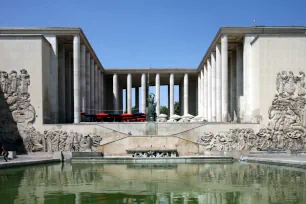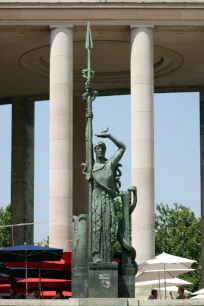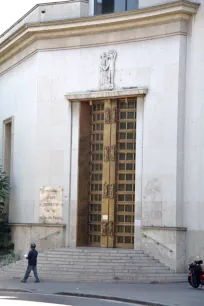The Palais de Tokyo opened in 1937 as the pavilion of modern art for the Universal Exposition held that year on the Chaillot Hill. Today the building is still home to two galleries of modern art, one with a collection of twentieth-century art and another one dedicated to contemporary art.
The Building
History

The Palais de Tokyo was built for the International Art and Technical Exhibition of 1937. The theme of the exhibition was the harmony between technology and art in modern life. The main pavilion was the Palais de Chaillot, which was built on top of the Chaillot hill opposite the Eiffel Tower.
The Palais de Tokyo was built on a slope of the same hill, near the Seine river, as the pavilion for modern art. The avenue separating the Palais de Tokyo, the Avenue de New York, was named Avenue de Tokio at the time, which explains the name of the pavilion. The street was renamed after the end of the Second World War. Construction of the Palais de Tokyo started in July 1936. The building was completed in less than a year’s time and was inaugurated in May 1937, during the World Exhibition.



During the war, under German occupation, the pavilion was used for the exhibits of works from living artists. The pavilion became a permanent museum in 1961, when the municipal collection of modern art was moved to the ground floor of the Palais de Tokyo.
Architecture
The design of the Palais de Tokyo was created by the architects Jean-Claude Dondel, André Aubert, Paul Viard and Marcel Dastugue. They employed a monumental architectural style that fit right in with the bombastic nationalist architecture that was popular in the late 1930s, in particular in Nazi Germany and Communist Russia.
The four architects created a large complex with two separate wings that open up towards the river. The two wings are connected by a covered colonnade. Two staircases in the direction of the Seine connect the colonnade with a plaza below, dominated by a fountain with a large rectangular basin.
Two enormous reliefs against the building’s facades form a dramatic backdrop for the fountain. The reliefs were created by Alfred Auguste Janniot and symbolize the nine muses. Statues of nymphs lie near the basin, and at the top of the staircases the bronze statue entitled ‘La France’ overlooks the basin below. The statue was created by Antoine Bourdelle, one of France’s most famous sculptors.
The Museums
The Palais de Tokyo was specifically built to house museums of modern art, so its interior is spacious and flexible and the lighting is ideal for the display of paintings. The east wing is home to the Musée d’Art Moderne de la Ville de Paris, the modern art museum of the city of Paris. The other wing is home to the Site de Création Contemporaine, which organizes temporary exhibits and events focused on contemporary art

Musée d’Art Moderne de la Ville de Paris
The Musée d’Art Moderne de la Ville de Paris was created in 1961 with the collection of modern art owned by the city of Paris.
The art collection of the city had grown too large and there was simply not enough space in the Petit Palais to display its collection of modern art, so it was spun off and moved to the Palais de Tokyo. This museum is now the municipal counterpart of the Centre Pompidou, which houses the national collection of modern art.
The permanent collection of the museum is on display on the lower floor, where it is arranged in chronological order, from Fauvism, Cubism and Dadaism over Surrealism to Nouvéau Réalisme and late twentieth-century art. The works, many of which are from French artists, are regularly rotated.
Site de Création Contemporaine
The Site de Création Contemporaine opened in 2002 in the west wing of the Palais de Tokyo. The gallery, which is now simply called ‘Palais de Tokyo’ organizes expositions, lectures and installations of contemporary and conceptual art in the west wing of the Palais de Tokyo. It is one of the largest galleries of its kind in Europe.
- Next: Parc de Bercy
- More Sights & Attractions in Paris

